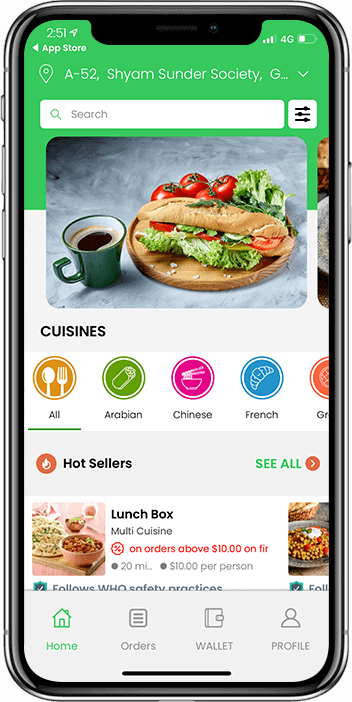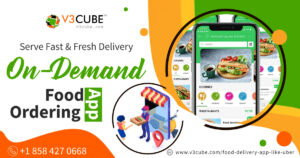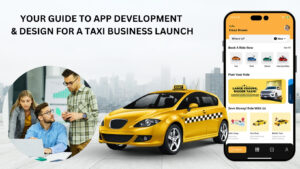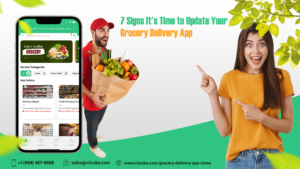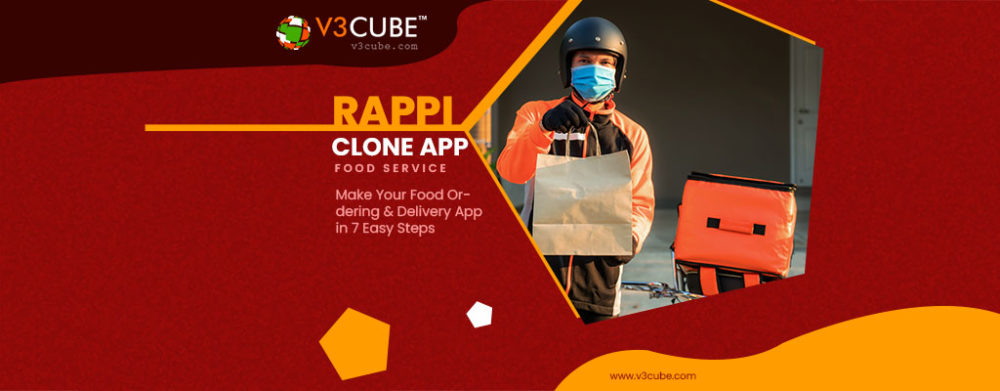
Develop own On-demand Food Delivery App has become popular among entrepreneurs and startups. To satisfy their clients, keeping up with the competitors, improving speed delivery, widen the customer base entrepreneurs can create food delivery apps. In this article, we will show you the must-have features for app and how to build in simple easy steps.
Online food delivery is not a new phenomenon but on-demand food delivery apps are in vogue. Gone are the days where people used to call the restaurant and place an order and the delivery was made by the eateries. With the world going mobile, on-demand apps are making things easier. Whether you have midnight cravings or wish to start your day early with a healthy breakfast, getting food delivery is never a problem now.
How Does On-demand Food Delivery Work?
On-demand Food Delivery Script Solutions facilitates the delivery of your favorite meals from nearby local restaurants. The doordash clone app enables the customers to order food from a variety of establishments with a single tap from the smartphone.
The order is received by the restaurant that further proceeds with the order processing and packaging the same. The next step is the order is picked up by the delivery driver. The confirmation is sent to the customer and the package is delivered as how it was said. The delivery driver will collect the cash if the customer has opted for Cash on delivery. The app asks for feedback and ratings.
Coming over to the crucial part, how to build your ubereats clone app in simple and easy steps. Let’s break down the steps discussing the same:
1. Validating your Food delivery app idea
Why do you want to develop a food delivery app? Just because it is trending and you should develop one should not be the case. Know if your idea of making a food delivery app is worth investing in? If yes move further with what kind of food delivery app solution you wish to create. Do you want to create a new app right from the scratch or build UberEats Clone App, Swiggy Clone, Postmates Clone, etc? There are several successful business models that you can take inspiration from and launch your ubereats clone app in as quick as 5 days.
2. Identifying the right niche
It’s that when you are developing a food delivery app, with the thought that everyone loves food. So, everyone is going to use it.
This is where you might go wrong. Food delivery app is instant to catch attention as people love to explore the possibilities. But, there is one thing that the majority of the apps fail to consider is identifying the niche of the apps. To make your food delivery app successful, determine your target audience. Who will be using your app?
- Students, professionals, busy moms, people on the go
- What kind of food they are preferring, restaurant-quality dishes, fast food?
- Are they vegetarians, vegans, plant-based diet people, or hard-core non-vegetarians?
- Once you have analyzed these factors you will be able to provide personalized food ordering experience to your customers.
3. Fix a food delivery model
What kind of food delivery model do you wish to develop? There are 3 types of food apps model:
- The marketplace model
It is one of the most preferred models when it comes to developing an online food delivery solution. Earns you a steady commission from multiple channels without losing control over the business. The on-demand food delivery app bridges the gap by onboarding various types of restaurants connecting with the customers. The customers get to order from the nearby restaurants. The more the restaurants onboarded with the app the better the revenue generation and app awareness.
Here you can have your delivery fleet or hire a 3rd party delivery fleet to take care of the food deliveries.
- Single food delivery app
It is ideal for those who are running a restaurant of their own. The owner can develop a single app where he/she will take care of the entire business activities. Right from processing the food orders to delivering. The plus point of developing a single food delivery app is there is no profit sharing here but the sole app owner itself. However, it will require a great level of commitment to ensure the orders are processed on time and delivered accordingly.
- Chain of restaurants app
This is the best food model for those running chains of restaurants. The customers will place an order like usual and the nearest chain will process and make the delivery.
4. Requirements of the developing any food delivery model
Ideally, the on-demand food delivery solution will require having separate app panels. This include:
- Customer app
- Restaurant app
- The delivery driver app
- The admin app
For every separate app, the workflow is synced with one another to ensure seamless food ordering and delivery operations. Take the live demo of the UberEats Clone App to know the working mechanism of every panel, which provides you better clarity.
5. 2021 New Version features
Features play an important part in making or breaking the app. If your food delivery app does not have user-centric features, your customers will soon lose interest and uninstall the app.
The features have to be such that it not only helps the users but the appreneur and restaurants. Thus, making a win-win situation of developing an intuitive food delivery solution.
If you are looking to develop an app Postmates, have the following features integrated:
- Restaurant wise commission
- Daywise separate time slots
- Restaurants as well as Item name searching
- Voice instructions store delivery drivers
- Restaurants to upload pictures of their kitchen
- Order cancellation option for delivery drivers
- Contactless deliveries
- Safety badge
- Graphical status of orders via in-app notifications
- Multiple payment modes
- In-app chat/call support
- Multiple language/currency support
- Live-tracking
6. The tech stack to build a robust food delivery app
We have provided you with the list of new features to have implemented in your app. Now let’s discuss the technology stack that you need to make your app operations flawless.
For the registrations and login process, you can use Autho technology. It has earned the reputation of offering secured authorization processes such as – email authorization, SMS, etc.
To make your eateries interactive, add details using Google Places API.
Let your customers enjoy ordering with peace of mind that their financial data is completely safe. To integrate a secure payment gateway, you can implement Stripe SDK, Flutterwave, Zoop Payment, Payu payment, Braintree, use Braintree, Paymentez, Paybox, Lugu, etc.
Inbuilt route optimization will help the delivery driver to know the best routes, ensuring the delivery is made on time.
7. UI/ UX Design And Tech Factors to consider
You can’t ignore the power of the UX design that makes your food delivery instant hit. An interactive UX design ensures that your food delivery app is easy to navigate. It is offering a pleasant ordering experience with a quick checkout process.
Make sure that your interface isn’t flashy but minimalist. Keep it neat, with only relevant information flashing on the screen. Make sure the content is well-organized and adds value to your app.
8. The cost of food delivery app development
Last but not the least, no matter what type of food delivery app you are developing it comes with a price tag. So, how much your food delivery app will cost. It depends on several factors like:
- OS Platform
- Technology stack used
- Customized features
- UX design
- Geographical locations
- App development company
Choosing The Right Food Delivery App Development Partner
Hiring a trusted UberEats App Development Company is important who will help you in delivering a successful app. The app development team should be able to understand your app objectives.
The right food ordering and delivering app development company will launch your app within the said deadline which can be a week max. Another added advantage of developing an on-demand food delivery app by the company means it is 100% white-label, built on the open-source code. It is a licensed version with the commitment from the app development team that will standby whenever you need technical help. This is not found in freelancers. Thus, it is always advisable to go hire an app development company if you want quality service within minimum time and budget.
